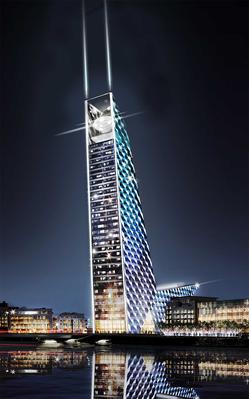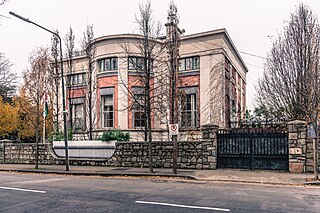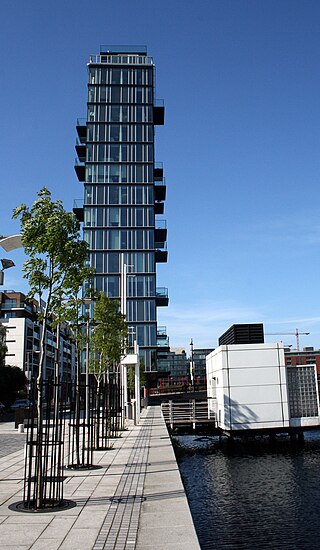
Ringsend is a southside inner suburb of Dublin, Ireland. It is located on the south bank of the River Liffey and east of the River Dodder, about two kilometres east of the city centre. It is the southern terminus of the East Link Toll Bridge. Areas included in Ringsend are the south side of the Dublin Docklands, and at the west end is the area of South Lotts and part of the Grand Canal Dock area. Neighbouring areas include Irishtown, Sandymount and the Beggars Bush part of Ballsbridge to the south, and the city centre to the west. A key feature of the area is the chimneys of Poolbeg power station.

Spencer Dock is a former wharf area, close to where the Royal Canal meets the River Liffey, in the North Wall area of Dublin, Ireland. As of the 21st century, the area has been redeveloped with occupants of the Spencer Dock development including the Convention Centre Dublin, PricewaterhouseCoopers' Irish headquarters, Credit Suisse and TMF Group. The Central Bank of Ireland and NTMA have offices in the nearby Dublin Landings development.

Seán O'Casey Bridge is a pedestrian swingbridge spanning the River Liffey in Dublin, Ireland, joining City Quay in the Grand Canal Docks area to North Wall Quay and the IFSC.
The Dublin Docklands Development Authority (Irish: Údarás Forbartha Dugthailte Bhaile Átha Cliath) (DDDA) was created by the Dublin Docklands Development Authority Act 1997 to lead a major project of physical, social and economic regeneration in the East side of Dublin, Ireland, along both banks of the River Liffey. On 31 May 2012 the Irish government announced its intention to wind up the Authority. The full dissolution was due to take place in May 2014 with a plan to phase the organisation into the Docklands Consultative Forum. At the time, this plan was postponed due to disengagement of the DDDA leading up to the dissolution date. The Authority was officially dissolved on 1 March 2016.

Dublin Docklands is an area of the city of Dublin, Ireland, on both sides of the River Liffey, roughly from Talbot Memorial Bridge eastwards to the 3Arena. It mainly falls within the city's D01 and D02 postal districts but includes some of the urban fringes of the D04 district on its southernmost side.

The U2 Tower was a cancelled skyscraper which was proposed to be constructed in Dublin, Ireland. The site proposed was in the South Docklands (SODO) campshires, at the corner of Sir John Rogerson's Quay and Britain Quay, by the confluence of the River Liffey, the River Dodder, and the Grand Canal. The design announced on 12 October 2007 was by Foster and Partners. Reports suggested a building height of 120 metres, "well over 120 metres", and 180 metres, any of which would have made it the tallest building on the island of Ireland. The building was planned to be an apartment building, with a recording studio owned by the rock group U2 in a "pod" at the top. Construction was to begin in 2008 and end in 2011, at a cost of €200m. In October 2008, the project was cancelled because of the economic downturn at the time. Proposals to revive the plan were reported in July 2013. However, they did not come to fruition and the 79-metre, 22-storey Capital Dock development has since been built on the site.

The Point Village is a commercial and residential development in the North Wall area of Dublin, Ireland. The elements of the €800 million development completed to date include offices and residential and hotel accommodation, a small shopping centre, a cinema, a museum and a five-level underground car park. The development ran into a number of problems and was taken over by NAMA in April 2013.

Sir John Rogerson's Quay is a street and quay in Dublin on the south bank of the River Liffey between City Quay in the west and Britain Quay. Named for politician and property developer Sir John Rogerson (1648–1724), the quay was formerly part of Dublin Port. It has some of the few remaining campshire warehouses in Dublin.

Britain Quay is a street and quay in Dublin on the south bank of the River Liffey between Sir John Rogerson's Quay and the confluence of the River Liffey, River Dodder and Grand Canal.

Boland's Mill is located on the Grand Canal Dock in Dublin, Ireland on Ringsend Road between the inner basin of Grand Canal Dock and Barrow Street. As of 2019, it was undergoing a €150 million reconstruction to become Bolands Quay, a development of new residences and commercial, retail, and civic spaces. The site, originally associated with Boland's Bakery, includes a number of 19th century warehouses.

South Lotts is a small area to the south of the river Liffey in inner-city Dublin 4, one km east of Dublin City Centre, Ireland. It was created following the embankment of the River Liffey in 1711 between the city and Ringsend, thereby reclaiming the marshes as North and South Lotts. It is at the westernmost end of Ringsend, overlapping with the Grand Canal Dock area, but is generally accepted to be within Ringsend.

The Bord Gáis Energy Theatre is a performing arts venue, located in the Docklands of Dublin, Ireland. It is Ireland's largest fixed-seat theatre. It was designed by Daniel Libeskind for the DDDA, built by Joe O'Reilly, and opened by Harry Crosbie on 18 March 2010. It is owned by Bernie and John Gallagher, who bought the theatre in 2014 from NAMA, through their company, Crownway.

John Ronan is an Irish businessman and property developer known for establishing Treasury Holdings in 1989 along with Richard Barrett.

Silicon Docks is a nickname for the area in Dublin, Ireland around Grand Canal Dock, stretching to the IFSC, city centre east, and city centre south near the Grand Canal. The nickname makes reference to Silicon Valley, and was adopted because of the concentration of European headquarters of high-tech companies such as Google, Facebook, Twitter, LinkedIn, Indeed and startups in the area. The number of tech professionals working in technology firms in the area is about 7,000.
The Docklands Strategic Development Zone (SDZ) (known officially as the North Lotts and Grand Canal Dock SDZ Planning Scheme) is a controversial strategic planning area in Dublin, Ireland located east of the city centre on both sides of the River Liffey in the North Wall and Grand Canal Dock areas.

Alto Vetro is a 16-storey residential tower on the west side of Grand Canal Dock, to the south of MacMahon Bridge, in Dublin, Ireland. The structure contains 26 apartments, 24 of them two-bedroom, the top two being three-bedroom triplex penthouses. There is a coffee shop and barbers at ground floor level.

Misery Hill is a street in Dublin, Ireland, near Grand Canal Dock.

Harry Crosbie, OBE is an Irish property developer and entrepreneur from the Dublin suburb of Drumcondra. He is known for his work in redeveloping the Dublin Docklands, and his association with arts and events venues in Dublin city, including the Convention Centre, Vicar Street, The Point Depot/3Arena and the Grand Canal Theatre, as well as the Point Village, and the Wheel of Dublin ferris wheel.





















